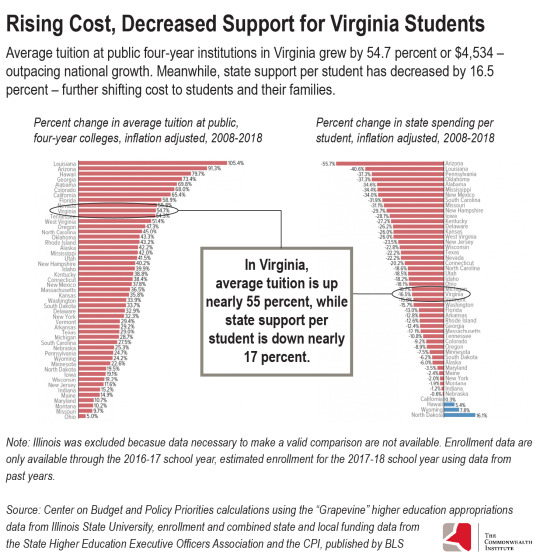October 16, 2018
The Great Shift: Students Pay More in College Costs, While the State Contributes Less
Virginia’s inadequate investment in public colleges and universities over the last decade has contributed to rising tuition prices, often leaving students with little choice but to take on more debt or give up on their dreams of going to college. The problem is especially serious for Black, Latinx, and low-income students.
Virginia is one of 45 states that spent less per student in the 2018 school year than in 2008, after adjusting for inflation—even as the economy and state budgets have returned to pre-recession levels, according to a new national report from the Center on Budget and Policy Priorities.
Virginia currently spends 16.5 percent or $1,306 less per student than it did in 2008, when adjusted for inflation. Though Virginia has made some improvements in reinvesting in public higher education over the last decade, state support still remains below pre-recession levels.
Inadequate state support for higher education has a significant impact on public colleges and universities because they typically rely heavily on state appropriations for support.
Cuts to higher education have helped drive up the cost of attending public colleges and universities. Between 2008 and 2018, the average tuition at public four-year institutions in Virginia grew by 54.7 percent or $4,534—outpacing the national growth of 36 percent and further shifting cost to students and their families.

Higher education yields benefits for both the individual and the state and in 1976 the General Assembly established a higher education cost-share policy by which the cost of education can be shared between the student and the state.
When the cost-share policy was first enacted, the state sought to cover 70 percent of the cost of education at four-year institutions. As recently as the 2001-2002 school year, the state was covering 77 percent of educational costs for in-state students, leaving students and their families on the hook to cover the remaining 23 percent.
But in the years since, the state has pulled back from covering its fair share. According to the State Council of Higher Education for Virginia’s 2018-2019 Tuition & Fee Report, Virginia undergraduate students will pay on average 55 percent of the cost of their education this school year.
Slow income growth has worsened the situation. While the average tuition bill increased by 36 percent across the country between 2008 and 2018, real median incomes only grew by just over 2 percent. In Virginia, the average tuition bill increased by nearly 55 percent between 2008 and 2018, and real median incomes for Virginia families only grew about 2.4 percent between 2008 and 2017 (2018 data will be available next September). Nationally, the average in-state tuition and fees at a four-year public college accounted for 16.5 percent of median household income in 2017, up from 14 percent in 2008.
In Virginia, a college education is even less affordable, especially for Black and Latinx families. In 2017, the average tuition and fees at a public four-year universities accounted for 17 percent of the median household income for all Virginia families. However, it accounted for 25 percent of median household income for Black families and 19 percent for Latinx families. While it only accounted for about 16 percent for White families and 12 percent for Asian families, both below the state average.
Federal and state financial aid has failed to bridge the gap created by rising tuition and relatively stagnant incomes. As a result, the share of students graduating with debt has risen. Between the 2008 and 2015 school years, the share of students graduating with debt from a public four-year institution rose from 55 percent to 59 percent nationally. The average amount of debt also increased during this period.
Adequate state investments for Virginia’s public colleges and universities is vital. When tuition increases low-income students and students of color are less likely to enroll in college because the cost of attending college seems insurmountable and out of reach.
To develop the skilled, diverse workforce we need to match the jobs of the future and to ensure that Virginians from all walks of life have access to an affordable higher education, Virginia must take serious steps to reinvest in public colleges and universities.
Category:
Education
